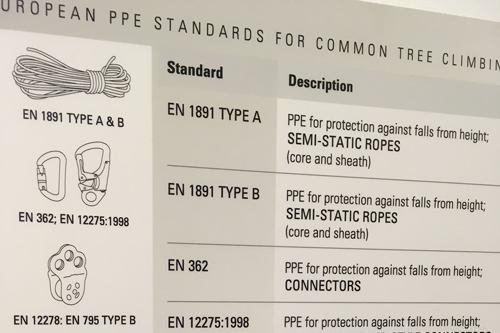Belying its physical size (wiro-bound A5), the recently published Approved Code of Practice for Safety and Health in Arboriculture is a significant New Zealand document - download your copy from WorkSafe NZ.
According to the Hon Kate Wilkinson, Minister of Labour "This Approved Code of Practice (Section 20 Health and Safety in Employment Act) is a statement of preferred work practices. A court may consider it when considering compliance with relevant sections of the HSE Act. If an employer can show compliance with the matters it covers (in the event of an accident: highlight by Treetools), a Court may consider the employer has complied with the Act".
Only one problem; the simplistic '22kN Rule' referred to in the document means New Zealand arb businesses cannot comply with the Act (unless they want remain in the proverbial dark ages).
Natural crotched, closed system only please (and no Yale Blaze)
The blanket 22kN Rule virtually eliminates all EN Compliant tree climbing equipment available on the NZ market today.
In theory, at least, NZ arb companies cannot comply with the tree climbing procedures set out in the ACOP unless they are natural crotching on a Blake's Hitch. Even with this trusty 'closed system' tree climbing configuration 95% of the Work Positioning harnesses currently available in NZ would not comply (the bridge and side D' only need reach 15kN to comply with EN 358 and EN 813).
Without wishing to cast aspersions on closed system tree climbing configurations this is just plain silly; progressive (and intelligent) aerial arborists will simply ignore the ACOP tree climbing recommendations, thereby breaching the guidelines set out in the document, possibly breaking the law in the process.
KISS Principle in action
One can only assume the '22kN Rule' was put in place to keep things simple (for either the document authors or perhaps future potential readers - see previous blog post on the subject here).
Having published our own 'comparison chart' documenting the various ratings common to modern tree climbing equipment Treetools can appreciate the difficulty experienced when partnering specific European Standards with stated kN ratings - download the comparison chart here.
But it can be done. Even if, in some cases, the kN ratings are irrelevant in terms of tensile strength.
A quick perusal of the Treetools chart shows the small number of EN compliant products that actually require a 22kN or above rating - view this Petzl link for more interactive data (the only Petzl reference out-of-date is EN 795 for Temporary Anchor Devices - read cambium saver and friction hitch - the 10kN rating stated by Petzl was raised to 18kN in 2012 following a revision of the Standard.
The Ministry of Business, Innovation and Development, the Department of Labour and NZ Arb need to re-think the 22kN Rule before aerial arborists relegate the ACOP to; 'it will come in handy, even if I never use it' status.

